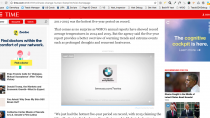Videology、Viewabilityに関するレポートを公開
Videology—one of the world’s leading video advertising technology platforms—today released research findings on viewable video impressions that illustrate the complexities still surrounding viewability, and issued caution in using viewability ratings as the primary gauge of campaign performance. The findings also suggest that technology can help advertisers improve the percentage of ads viewed by consumers through proper targeting and improved ad relevancy.
According to IAB minimum standards, for an in-stream video ad, 50% of its area must be displayed for at least two seconds to count as “viewable.” While poor viewability is often equated with low quality inventory, Videology’s research revealed two key findings that suggest consumer behavior, more specifically the action of clicking away from an ad before the designated continuous two seconds, also contributes to low viewability scores. The findings show:
- Advanced ad targeting, and subsequently ad relevancy, improved viewability rankings significantly compared to those targeted by demographics only [Graph 1.] In a case study of a major auto advertiser, using the same inventory sources, ads targeted by demo showed a 31% viewability rating versus a 71% rating for those using behavioral targeting. This suggests that by using advanced targeting technology, advertisers have the power to significantly improve the viewability of a video campaign.
- In addition, certain key ad categories perform significantly better than others in terms of viewability ranking across the same premium inventory sources [Graph 2.] Categories scoring the highest, including airline and political ads, had an average viewability rating of 86% and 74% respectively, triple those of the lowest ranking categories. Since there was no difference in the premium sites where the inventory ran, this implies greater, inherent consumer interest in certain categories, and/or more engaging creative.
“Viewability continues to be a hot button issue for the industry. It’s important, however, to understand it in its full complexity and not to look at the issues surrounding viewability with too narrow of a lens,” said Quinn Sanders, Director, Product Management, Videology. “A full-range of quality controls are necessary to ensure the best opportunity for consumers to see an advertisement, but technology can also arm advertisers and publishers alike with the tools necessary to help guide creative and other factors that influence viewability. The opportunity for viewers to see an ad is critical, but the ability to influence how long they engage with the ad is also important and achievable.”
The research also suggests that using viewability as the primary criteria of campaign performance (including the use of viewability as a currency whereby advertisers only pay for viewable impressions), may place undue restrictions on video inventory since not all video ad impressions are measurable for viewability. Specifically, ads served over a VAST ad call are not measurable for viewability; only ads served over a VPAID standard are measurable.
Currently, approximately 30% of video inventory—often the most highly coveted, FEP player inventory—is not measurable for viewability, and therefore cannot be included in video campaigns transacted on viewability. Yet, importantly, Videology’s research found:
- Inventory that cannot be measured for viewability can perform on par or better than campaigns with above average viewability ratings in terms of driving offline sales. [Graph 3.] Specifically, Videology analyzed SalesImpact™ studies for three CPG brands, comparing advertising impressions that scored over 50% viewability with impressions not measurable for viewability. Results showed that in one case high viewability surpassed unmeasurable impressions in ability to sales lift; in one case, immeasurable impressions surpassed high viewability; and in the third case, the results were basically equal.
“The role of our technology is to help marketers make smarter decisions, and tools that measure viewability certainly do that,” added Sanders. “But the danger is to give too much weight to any one proxy metric, whether that’s click-through rates or viewable impressions, and lose sight of the actual desired outcomes. As this research shows, advertisers can use our technology to gain a fuller understanding of the implications of viewability on their business in order to make the most efficient use of their dollars.”
Videology was one of the first technology platforms to receive Media Rating Council (MRC) accreditation for its measurement of viewable video impressions in May, 2014. MRC accreditation was based on an audit that assessed Videology’s compliance with MRC’s Minimum Standards for Media Rating Research, applicable IAB Measurement Guidelines, and the Viewable Impression Measurement Guidelines draft released by MRC.
About Videology
Videology (videologygroup.com) is one of the world’s leading video advertising technology platforms. By simplifying big data, we empower marketers and media companies to make smarter advertising decisions to fully harness the value of their audience across screens. Our math and science-based technology enables our customers to manage, measure and optimize digital video and TV advertising to achieve the best results in the converging media landscape.












